- Back to Home »
- What fueled the Colorado floods
- NEW: Boulder County says only 4 still unaccounted for
- Boulder saw nearly half its annual rainfall in a single day
- "It all happened fairly quickly," a scientist says
- Nebraska warily watches the rising South Platte
(CNN) -- The steep, picturesque canyons that wind through Colorado's northern Front Range have been a draw for tourists, day-trippers and homebuyers for more than a century.
But when record-setting rainfall began to hit last week, those picturesque canyons became funnels that poured hundreds of tons of water per second into towns like Boulder, Longmont and Lyons and left hundreds stranded in the mountains above.
"This flood was a direct result of the large amount of rainfall that occurred in a widespread area, essentially from Denver north to almost the Wyoming state line, and for a long duration -- for about a 48-hour period last week," said Robert Kimbrough, a hydrologist with the U.S. Geological Survey in Denver.
Coloradans are still digging out from those floods, which have been up to 1,000-year events in some communities.
 Residents remove waterlogged and contaminated belongings destroyed by flooding in Longmont, Colorado, on Wednesday, September 18. Massive flooding has left at least six people dead and damaged nearly 18,000 homes around the state.
Residents remove waterlogged and contaminated belongings destroyed by flooding in Longmont, Colorado, on Wednesday, September 18. Massive flooding has left at least six people dead and damaged nearly 18,000 homes around the state.  David Soleta, right, and family friend John Rice remove destroyed and contaminated walls on September 18 from Soleta's father-in-law's home, which was heavily damaged by floodwaters that swept through Longmont, Colorado.
David Soleta, right, and family friend John Rice remove destroyed and contaminated walls on September 18 from Soleta's father-in-law's home, which was heavily damaged by floodwaters that swept through Longmont, Colorado. 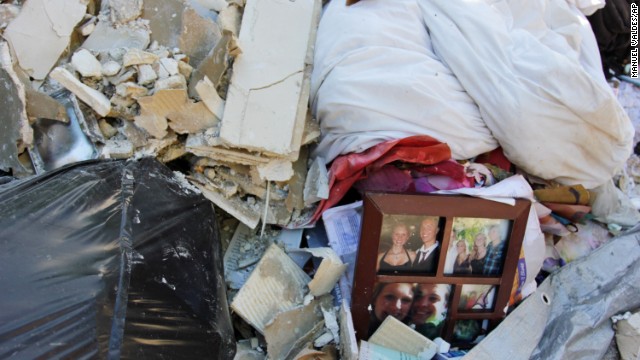 Trash and damaged mementos are piled outside Joan Fishburn's home in Boulder, Colorado, on September 18.
Trash and damaged mementos are piled outside Joan Fishburn's home in Boulder, Colorado, on September 18. 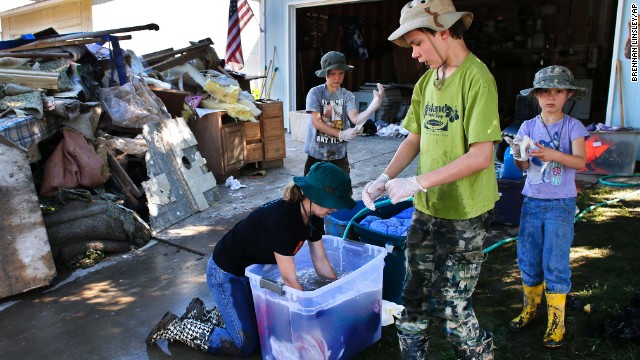 From left, siblings Elizabeth, 13, Jonathan, 9, Aaron, 11, and Kitty Dipert, 6, wash mud from the clothing of family friends from church on September 18 in Longmont, Colorado.
From left, siblings Elizabeth, 13, Jonathan, 9, Aaron, 11, and Kitty Dipert, 6, wash mud from the clothing of family friends from church on September 18 in Longmont, Colorado. 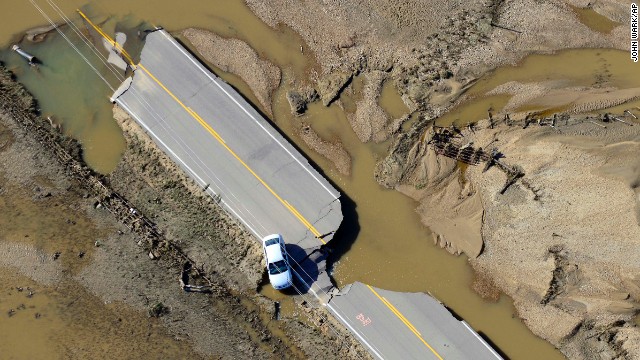 An abandoned car sits on a destroyed road along the South Platte River near Greeley, Colorado, on Tuesday, September 17.
An abandoned car sits on a destroyed road along the South Platte River near Greeley, Colorado, on Tuesday, September 17.  A Blackhawk helicopter flies over a canyon during a search around Boulder, Colorado, on September 17.
A Blackhawk helicopter flies over a canyon during a search around Boulder, Colorado, on September 17. 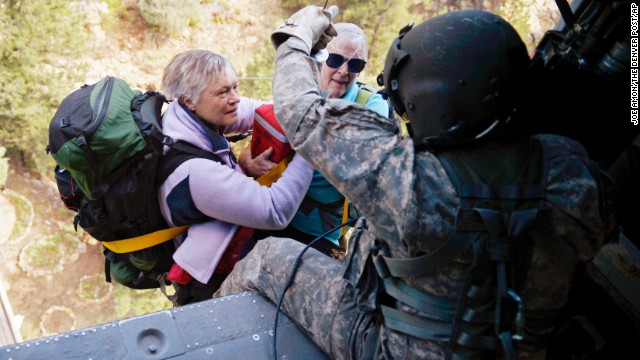 Two women are hoisted into a Blackhawk helicopter during a search and rescue mission near Jamestown, Colorado, on September 17.
Two women are hoisted into a Blackhawk helicopter during a search and rescue mission near Jamestown, Colorado, on September 17.  Two women smile and laugh after being rescued by a helicopter crew on September 17 near Jamestown, Colorado.
Two women smile and laugh after being rescued by a helicopter crew on September 17 near Jamestown, Colorado. 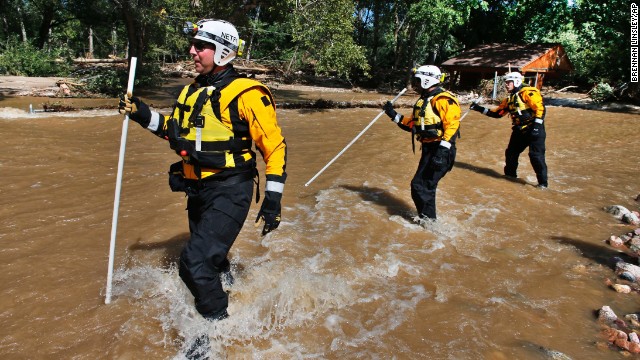 Members of the FEMA Urban Search and Rescue Nebraska Task Force 1 use probes to test for water depth while crossing floodwaters looking for missing people near Longmont, Colorado, on September 17. Stranded flood victims are being rescued by military helicopters and vehicles.
Members of the FEMA Urban Search and Rescue Nebraska Task Force 1 use probes to test for water depth while crossing floodwaters looking for missing people near Longmont, Colorado, on September 17. Stranded flood victims are being rescued by military helicopters and vehicles. 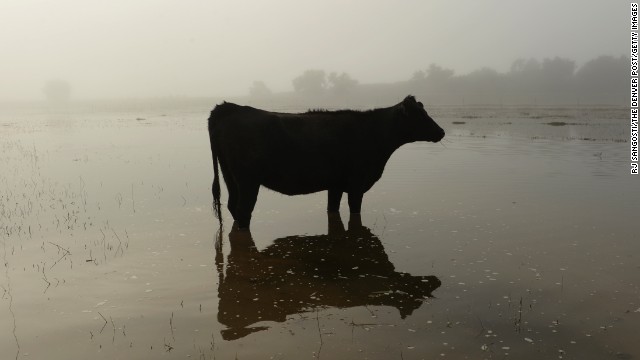 A cow stands in floodwater near Kersey, Colorado, on September 17.
A cow stands in floodwater near Kersey, Colorado, on September 17. 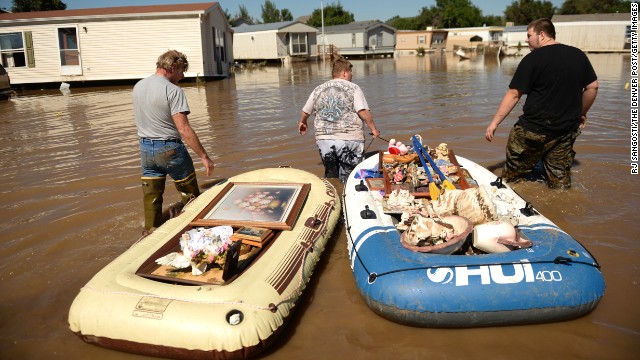 From left, Dale Reeves, Kathryn Reeves and Trent Mayes assist a family member by moving belongings from a flooded home in Evans, Colorado, on September 17.
From left, Dale Reeves, Kathryn Reeves and Trent Mayes assist a family member by moving belongings from a flooded home in Evans, Colorado, on September 17. 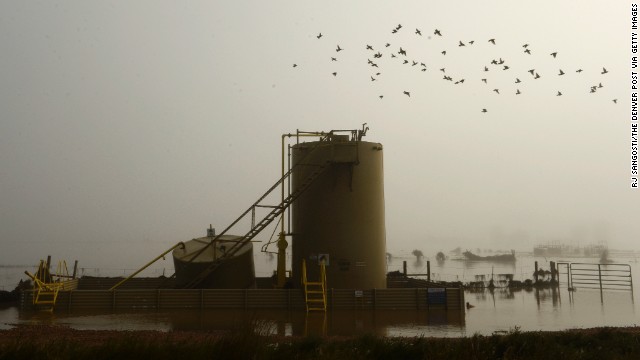 A gas well is surrounded by floodwater near Kersey, Colorado, on September 17.
A gas well is surrounded by floodwater near Kersey, Colorado, on September 17.  A woman steps over a puddle onto the foundation of a shed that was moved by floodwaters in Hygiene, Colorado, on Monday, September 16.
A woman steps over a puddle onto the foundation of a shed that was moved by floodwaters in Hygiene, Colorado, on Monday, September 16. 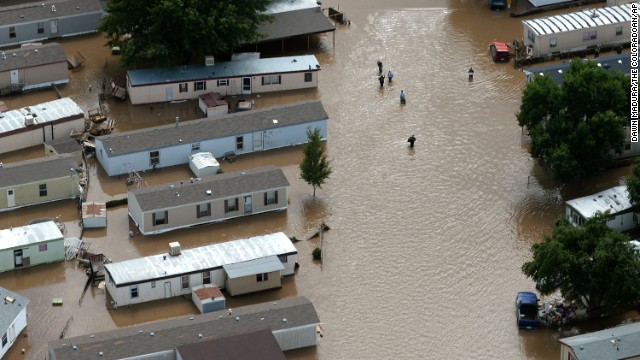 People wade through floodwater in Greeley, Colorado, on September 16.
People wade through floodwater in Greeley, Colorado, on September 16.  Jerrie McBride checks in with authorities after being rescued by helicopter from the Big Elk Meadows area in Boulder, Colorado, on September 16.
Jerrie McBride checks in with authorities after being rescued by helicopter from the Big Elk Meadows area in Boulder, Colorado, on September 16. 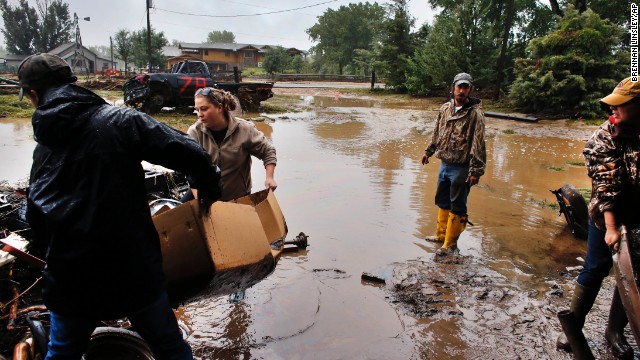 Local residents, from left, Levi Wolfe, Miranda Woodard, Tyler Sadar, and Genevieve Marquez help salvage and clean property after days of flooding in Hygeine, Colorado, on September 16.
Local residents, from left, Levi Wolfe, Miranda Woodard, Tyler Sadar, and Genevieve Marquez help salvage and clean property after days of flooding in Hygeine, Colorado, on September 16. 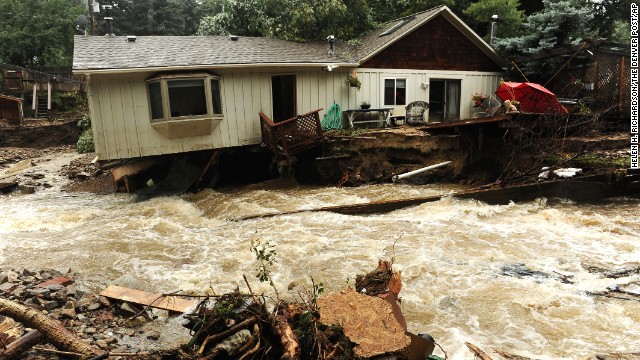 Floodwaters surround a home in Jamestown, Colorado, on Sunday, September 15.
Floodwaters surround a home in Jamestown, Colorado, on Sunday, September 15. 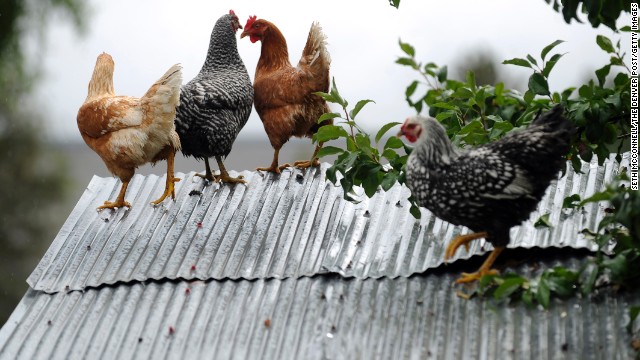 Chickens take refuge on the roof of their coop to escape floodwater in the backyard of a home in Longmont, Colorado, on September 15.
Chickens take refuge on the roof of their coop to escape floodwater in the backyard of a home in Longmont, Colorado, on September 15. 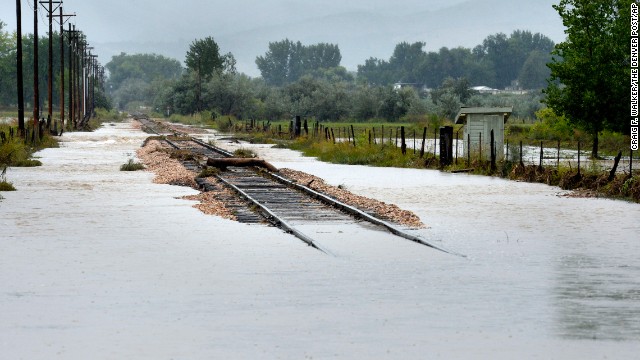 Railroad tracks are washed out in Longmont, Colorado, on September 15.
Railroad tracks are washed out in Longmont, Colorado, on September 15. 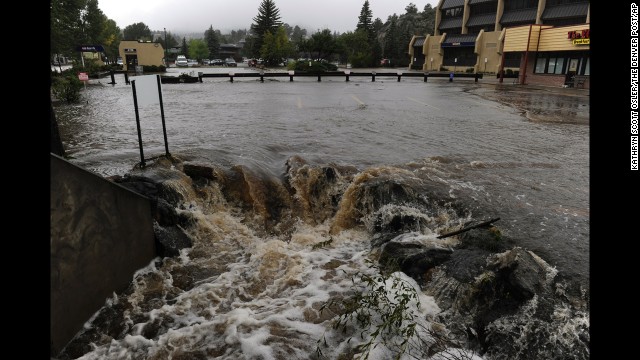 Water pours out of a parking lot, overwhelming a culvert heading under the roadway, in Estes Park, Colorado, on September 15.
Water pours out of a parking lot, overwhelming a culvert heading under the roadway, in Estes Park, Colorado, on September 15. 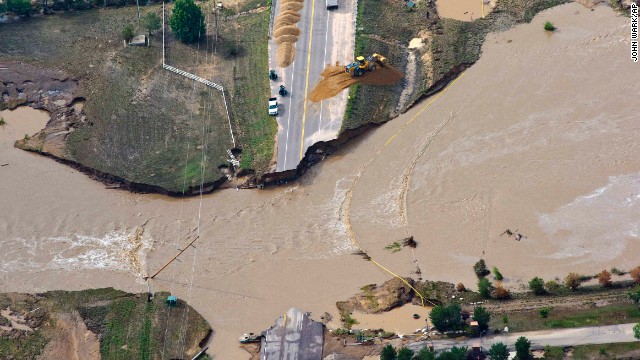 A road crew works on a stretch of highway washed away by flooding along the South Platte River near Greeley, Colorado, on Saturday, September 14.
A road crew works on a stretch of highway washed away by flooding along the South Platte River near Greeley, Colorado, on Saturday, September 14. 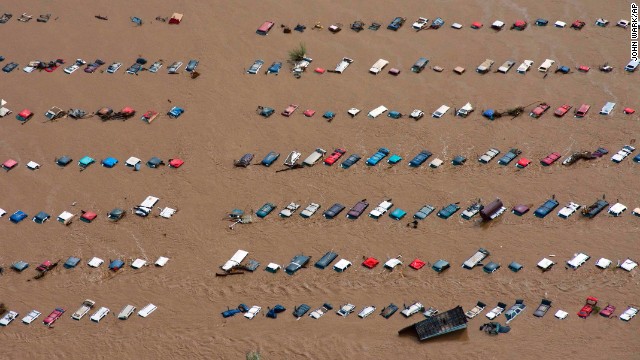 Parked vehicles sit partially submerged near Greeley, Colorado, on September 14.
Parked vehicles sit partially submerged near Greeley, Colorado, on September 14. 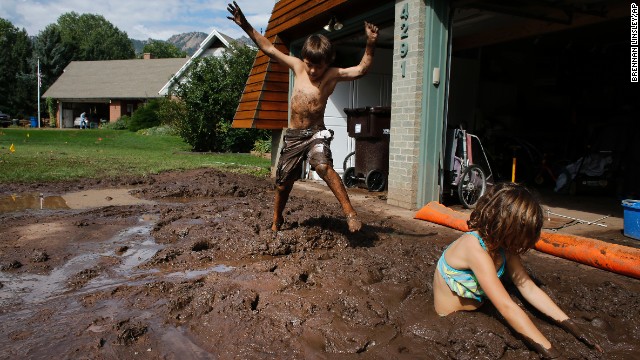 Eli and Noe Sura play in the mud around their Boulder, Colorado, home on September 14.
Eli and Noe Sura play in the mud around their Boulder, Colorado, home on September 14. 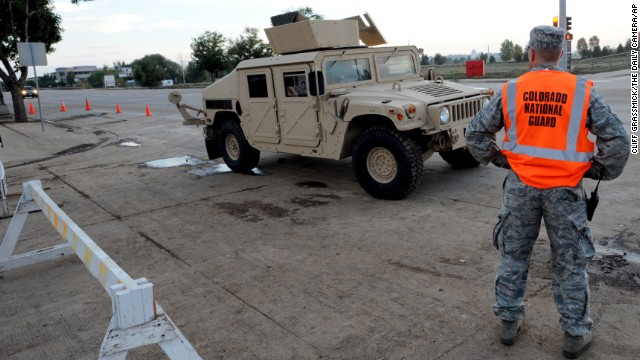 A National Guardsman stands at South Main and Missouri streets in Longmont, Colorado, on September 14.
A National Guardsman stands at South Main and Missouri streets in Longmont, Colorado, on September 14.  Floodwaters swamp Longmont, Colorado, on September 14.
Floodwaters swamp Longmont, Colorado, on September 14. 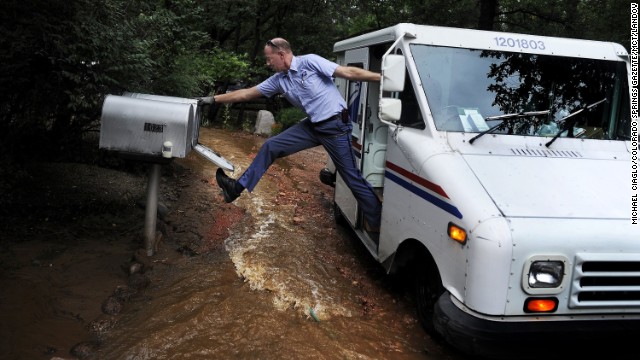 Dave Jackson closes a mailbox with his foot after delivering the mail to a home surrounded by water from the flooded Cheyenne Creek in Colorado Springs, Colorado, on Friday, September 13.
Dave Jackson closes a mailbox with his foot after delivering the mail to a home surrounded by water from the flooded Cheyenne Creek in Colorado Springs, Colorado, on Friday, September 13. 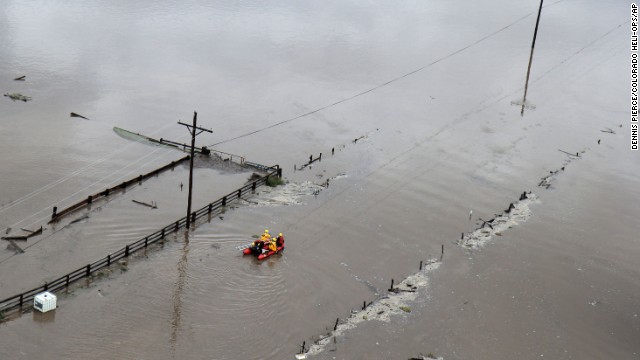 Rescue personnel search for flood victims near Fort Collins, Colorado, on September 13.
Rescue personnel search for flood victims near Fort Collins, Colorado, on September 13. 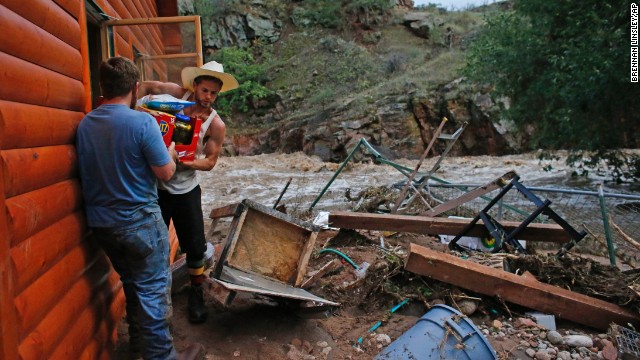 Chris Rodes helps Fred Rob salvage a friend's belongings after floods left homes and infrastructure in shambles in Lyons, Colorado, on September 13.
Chris Rodes helps Fred Rob salvage a friend's belongings after floods left homes and infrastructure in shambles in Lyons, Colorado, on September 13. 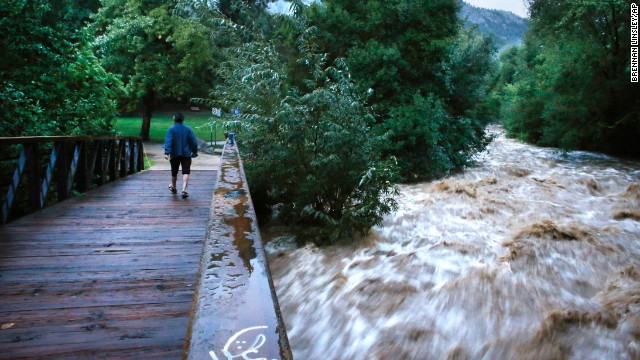 During a break in the rain, a woman walks over a footbridge past the raging Boulder Creek in Boulder on September 13. Boulder County is one of the hardest-hit areas.
During a break in the rain, a woman walks over a footbridge past the raging Boulder Creek in Boulder on September 13. Boulder County is one of the hardest-hit areas. 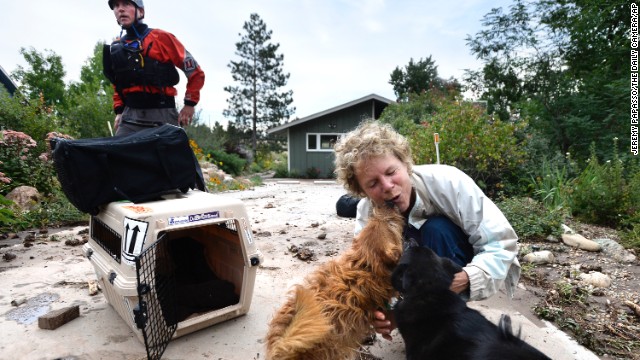 Suzanne Sophocles hugs her dogs after they were rescued from her flooded home on September 13 in Boulder. Thousands of people stranded by the flood waters in Colorado were finally able to come down by trucks and helicopters, two days after seemingly endless rain turned normally scenic rivers and creeks into coffee-colored rapids that wrecked scores of roads and wiped out neighborhoods.
Suzanne Sophocles hugs her dogs after they were rescued from her flooded home on September 13 in Boulder. Thousands of people stranded by the flood waters in Colorado were finally able to come down by trucks and helicopters, two days after seemingly endless rain turned normally scenic rivers and creeks into coffee-colored rapids that wrecked scores of roads and wiped out neighborhoods. 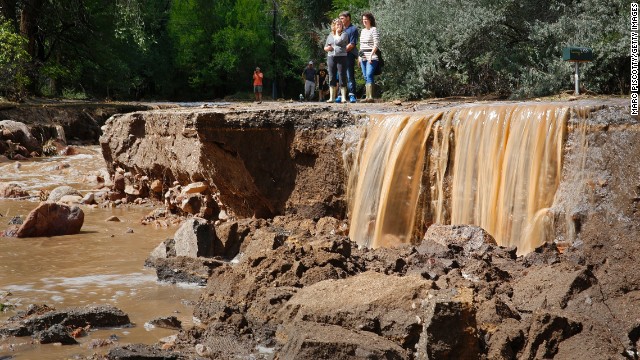 Residents look at the flood damage along Topaz Street in Boulder on September 13.
Residents look at the flood damage along Topaz Street in Boulder on September 13. 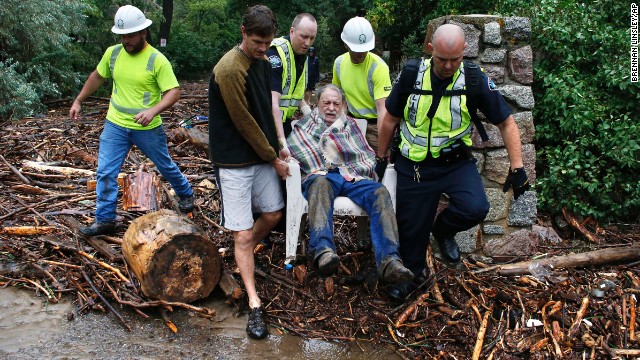 Will Pitner gets rescued by emergency workers and neighbor Jeff Writer on September 13 after he spent a night trapped outside above his home at the base of Boulder Canyon.
Will Pitner gets rescued by emergency workers and neighbor Jeff Writer on September 13 after he spent a night trapped outside above his home at the base of Boulder Canyon. 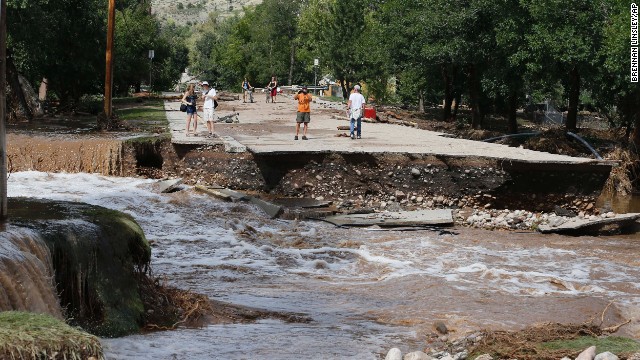 Water rushes where a bridge collapsed in a flash flood in Lyons, on September 13.
Water rushes where a bridge collapsed in a flash flood in Lyons, on September 13. 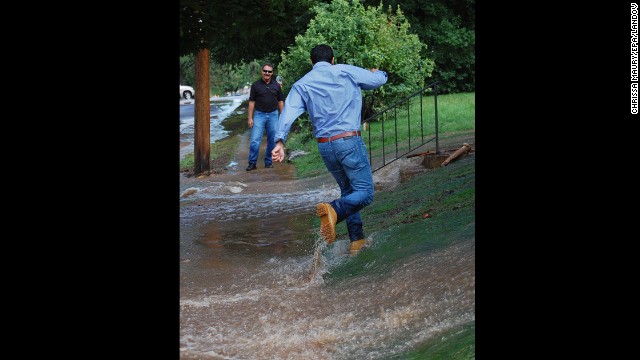 A man runs through the floodwaters in a yard in Boulder on September 13.
A man runs through the floodwaters in a yard in Boulder on September 13. 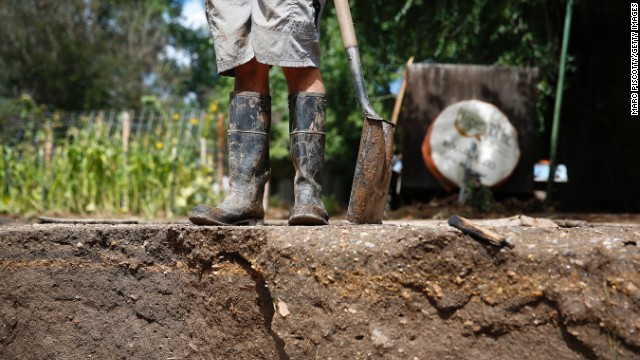 Topaz Street resident Jake Koplen stands at the edge of his driveway after the street in front of his home was washed away in Boulder on September 13.
Topaz Street resident Jake Koplen stands at the edge of his driveway after the street in front of his home was washed away in Boulder on September 13. 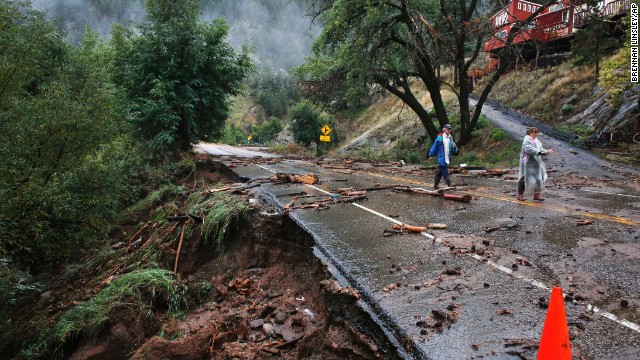 Siblings Patrick Tinsley and Mary Kerns head to Boulder from the mountain community of Magnolia, Colorado, on September 13.
Siblings Patrick Tinsley and Mary Kerns head to Boulder from the mountain community of Magnolia, Colorado, on September 13. 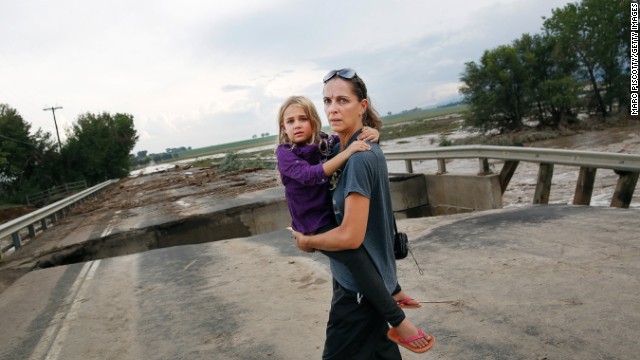 Samantha Kinzig of Longmont, Colorado, and her 5-year-old daughter, Isabel, take a closer look at the damaged bridge on Weld County Road 1 on September 13.
Samantha Kinzig of Longmont, Colorado, and her 5-year-old daughter, Isabel, take a closer look at the damaged bridge on Weld County Road 1 on September 13. 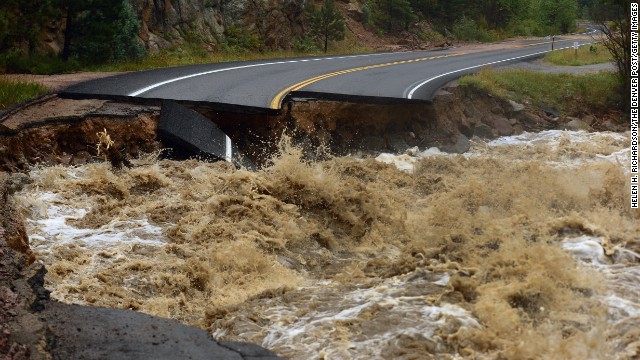 Highway 7 is completely blown out from the South St. Vrain River as a torrent of raging water rips through it about 12 miles west of Lyons on Thursday, September 12.
Highway 7 is completely blown out from the South St. Vrain River as a torrent of raging water rips through it about 12 miles west of Lyons on Thursday, September 12. 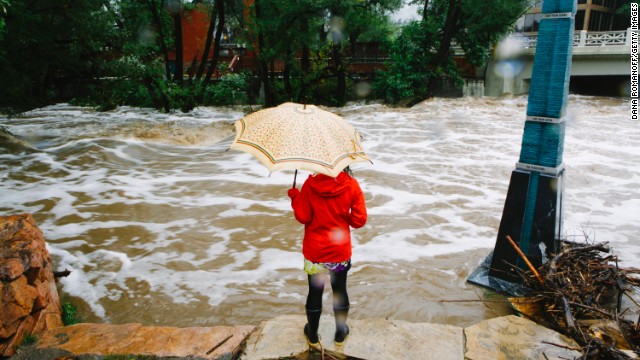 A woman looks at the flooded Boulder Creek on September 12.
A woman looks at the flooded Boulder Creek on September 12. 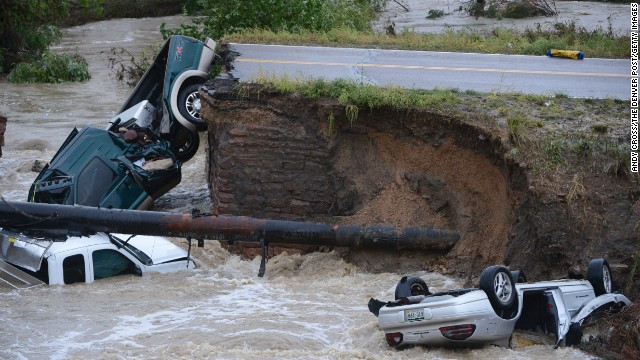 Three vehicles crashed into a creek after the road washed out from beneath them in Broomfield, Colorado, on September 12. Three people were rescued.
Three vehicles crashed into a creek after the road washed out from beneath them in Broomfield, Colorado, on September 12. Three people were rescued. 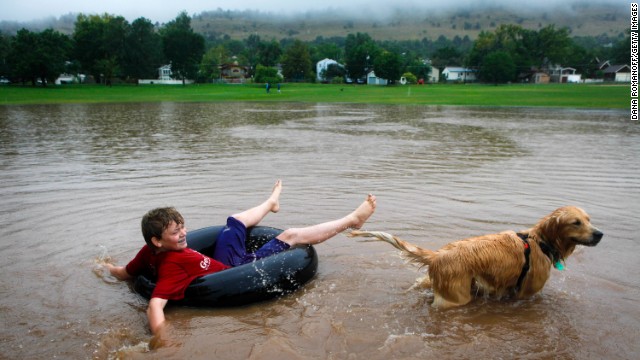 Nicky Toor, 15, floats on the flooded lawn of North Boulder Park in Boulder on September 12.
Nicky Toor, 15, floats on the flooded lawn of North Boulder Park in Boulder on September 12.  Joey Schusler rides through flooded Canyon Boulevard in Boulder, on September 12.
Joey Schusler rides through flooded Canyon Boulevard in Boulder, on September 12.  Residents view a road washed out by a torrent of water after overnight flash flooding near Left Hand Canyon, Colorado, on September 12.
Residents view a road washed out by a torrent of water after overnight flash flooding near Left Hand Canyon, Colorado, on September 12. 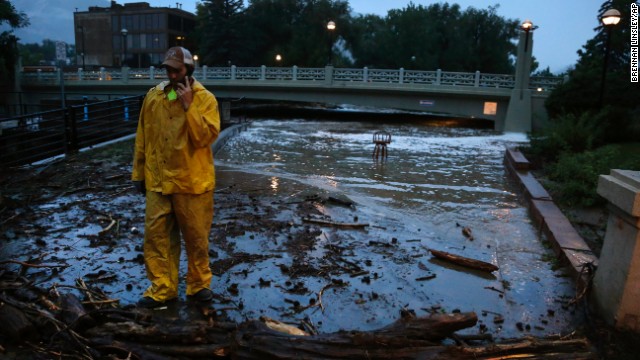 A city worker talks on his phone while surveying high water levels from Boulder Creek after flash flooding in downtown Boulder, Colorado, on September 12.
A city worker talks on his phone while surveying high water levels from Boulder Creek after flash flooding in downtown Boulder, Colorado, on September 12. 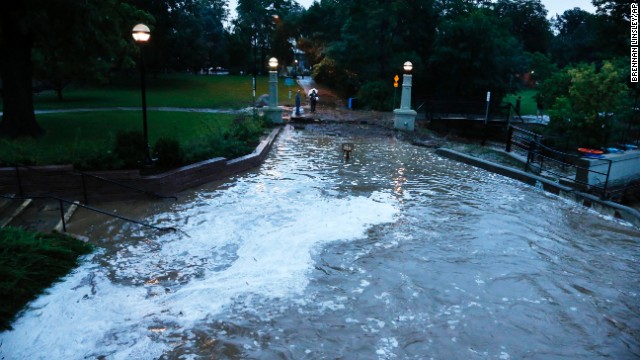 Flash flood waters rush over a walking path in downtown Boulder on September 12.
Flash flood waters rush over a walking path in downtown Boulder on September 12. 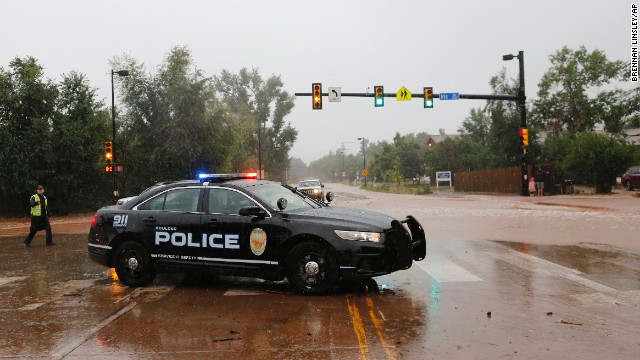 A police officer blocks off a road in Boulder on September 12.
A police officer blocks off a road in Boulder on September 12. 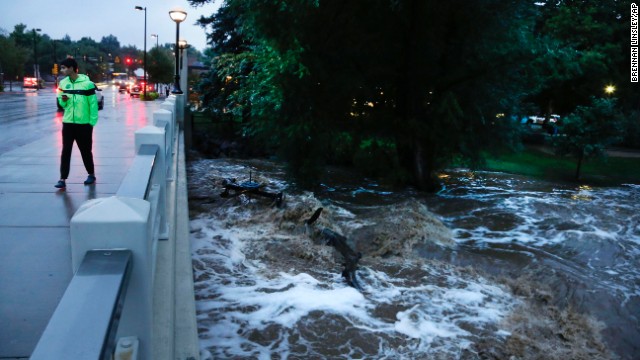 A man walks past the swelled Boulder Creek in Boulder on September 12.
A man walks past the swelled Boulder Creek in Boulder on September 12. 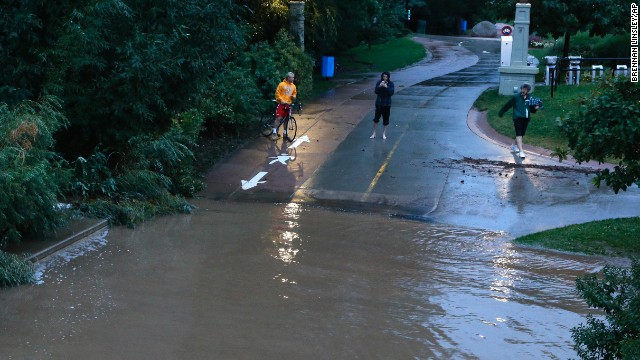 People stand at the edge of floodwaters in Boulder on September 12.
People stand at the edge of floodwaters in Boulder on September 12. 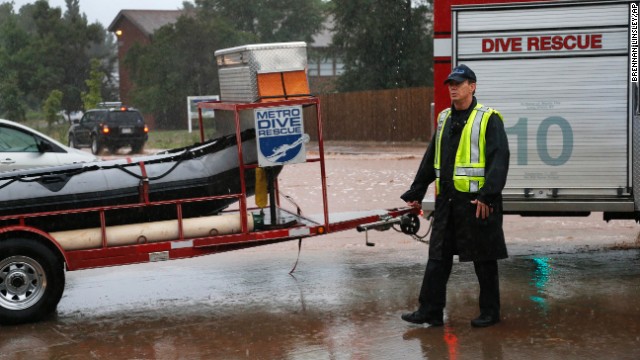 A dive rescue team moves toward floodwaters in Boulder on September 12.
A dive rescue team moves toward floodwaters in Boulder on September 12. 
1

2

3

4

5

6

7

8

9

10

11

12

13

14

15

16

17

18

19

20

21

22

23

24

25

26

27

28

29

30

31

32

33

34

35

36

37

38

39

40

41

42

43

44

45

46

47

48

49
 Photos: Deadly floods hit Colorado
Photos: Deadly floods hit Colorado 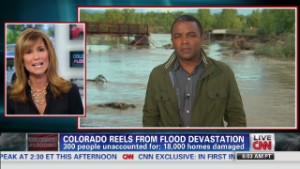 Colorado reels from flood devastation
Colorado reels from flood devastation 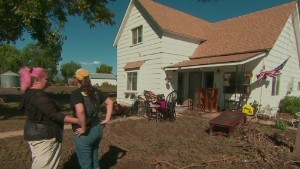 Wave in Colorado 'like a tsunami'
Wave in Colorado 'like a tsunami' A stream of unusually humid air that was sweeping over the area early last week helped fuel the storms. High pressure east of the mountains bumped up against a low-pressure system to the west, triggering several days of storms as moist air flowed up the peaks of the Rockies, where cold air wrung the water out of it.
The rain began September 10, with an inch recorded in Boulder. Nearly two inches fell the next day. Then on September 12, Boulder recorded 9.08 inches of rain -- nearly double the city's previous one-day record, and almost half its 20.5-inch yearly average. A forecaster in the National Weather Service office there called it "biblical."
More than 4 more inches of rain fell by the week's end, bringing the September total to more than 17 inches so far. That's boosted the yearly precipitation figure, measured from October through September, to more than 30 inches to date -- the most in 120 years of record-keeping.
The biggest rainfall amounts occurred over the foothills of the Rockies, Kimbrough said. That water poured down the mountainsides into the major tributaries of the South Platte River -- Boulder Creek and the St. Vrain, Big Thompson and Cache la Poudre rivers.
"It really originated in the streams that drain off the east side of the Continental Divide into the front range of Colorado, but it all happened fairly quickly," Kimbrough said. "Even though the leading edge was in the foothills, we did see it very quickly on the 12th in communities like Boulder and Lyons and Longmont."
 Sacrifice in Colorado's historic flood
Sacrifice in Colorado's historic flood 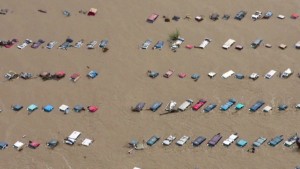 Massive flood rescue operation in Colorado
Massive flood rescue operation in Colorado The result was six dead and about 200 who remained unaccounted for, though most of those are believed to be alive and well. Boulder County reduced its count from 109 people to four still unaccounted for on Wednesday, while in Larimer County, to the north, the number remained at 197.
Nearly 18,000 homes have been damaged statewide. Now the runoff is coursing down the South Platte into neighboring Nebraska, where forecasters are warning of flooding into the weekend.
"We're in the Grand Island area anxiously waiting to see how the Platte River responds and to see how much of the water reaches us here," Mary Harner told CNN affiliate KHAS.
Many in Colorado returned home to heartbreaking scenes. In Lyons, on the St. Vrain River 15 miles north of Boulder, high water pushed entire houses around like furniture. Streets were dotted with snapped utility poles.
Stories of grief, generosity and gratitude
The extensive damage may present long-term problems for communities even as workers scramble to make repairs, Larimer County Sheriff Justin Smith said Tuesday. Questions of how to provide emergency services to areas where roads have been washed out or protect properties where the owners have been evacuated are still being worked out, he said.
"We have a new normal in Larimer County for months, if not a few years," Smith said.
CNN's Kyung Lah, Faith Karimi and Sean Morris contributed to this report.







